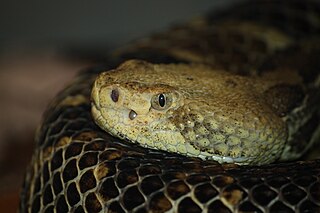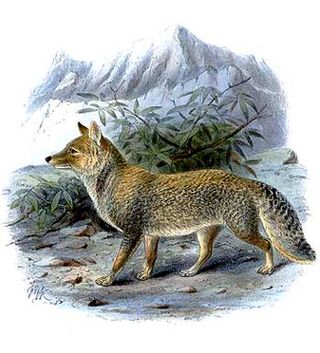
The Crotalinae, commonly known as pit vipers, or pit adders, are a subfamily of vipers found in Asia and the Americas. Like all other vipers, they are venomous. They are distinguished by the presence of a heat-sensing pit organ located between the eye and the nostril on both sides of the head. Currently, 23 genera and 155 species are recognized: These are also the only viperids found in the Americas. The groups of snakes represented here include rattlesnakes, lanceheads, and Asian pit vipers. The type genus for this subfamily is Crotalus, of which the type species is the timber rattlesnake, C. horridus.

Gloydius is a genus of venomous pitvipers endemic to Asia, also known as Asian moccasins or Asian ground pit vipers. Named after American herpetologist Howard K. Gloyd, this genus is very similar to the North American genus Agkistrodon. 24 species are currently recognized.

The Tibetan fox, also known as the Tibetan sand fox, is a species of true fox endemic to the high Tibetan Plateau, Ladakh plateau, Nepal, China, Sikkim, and Bhutan, up to elevations of about 5,300 m (17,400 ft). It is listed as Least Concern in the IUCN Red List, on account of its widespread range in the Tibetan Plateau's steppes and semi-deserts.

Gloydius himalayanus also known as the Himalayan pit viper or the Himalayan viper is a venomous pitviper species found along the southern slopes of the Himalayas in Pakistan, India and Nepal. No subspecies are currently recognized. Himalayan pit vipers have been found up to 4900m above sea level, which makes it the highest living snake ever found.

Gloydius halys is a venomous pitviper species found within a wide range that stretches across Asia, from Russia, east of the Urals, eastwards through China. Five subspecies are currently recognized, including the nominotypical form described here.
The Ganzu vole, Eva's red-backed vole, Eva's vole, Gansu vole, or Taozhou vole is a species of rodent in the family Cricetidae. It is found in mountain forests in China. The IUCN has assessed it as being of "least concern".
The Chinese jumping mouse is a species of rodent in the family Dipodidae. It is monotypic within the genus Eozapus. It is endemic to China where its natural habitat is temperate forests, steppes and meadows in mountainous regions. It is tolerant of some degree of habitat destruction, and the International Union for Conservation of Nature has assessed its conservation status as being of "least concern".

The Chinese red pika is a species of mammal in the family Ochotonidae. Typical of a pika it has short limbs, a small tail and round ears. Specific to the Chinese red pika has distinctive red color in its pelt. The Chinese pika typically lives in rocky terrain at altitudes between 600 and 1200 meters. and is endemic to the East Qinghai, West Gansu and Northern Sichuan provinces of China and Eastern Tibet.

Zoigê County or Ruo'ergai County is a county of Ngawa Tibetan and Qiang Autonomous Prefecture in Sichuan, China, bordering Gansu to the north. It is the northernmost county of the province. It is part of the Tibetan traditional region of Amdo.
Gloydius shedaoensis is a venomous pitviper species found only on Shedao Island in China. Although very small, this island is home to an extraordinarily large population of these snakes. No subspecies are currently recognized.
Gloydius strauchi is a species of venomous pit viper in the subfamily Crotalinae of the family Viperidae. The species is native to western China. It is a small snake with a pattern of four longitudinal stripes, although some older specimens may be a uniform black. G. strauchi may be distinguished from G. monticola by its higher midbody dorsal scale count. This species jointly holds the altitude record for pitvipers together with Crotalus triseriatus of Mexico, both being found even above the tree line at over 4,000 m (13,000 ft). No subspecies were recognized as being valid, until a recent publication re-evaluated the taxonomic statuses of populations of G. strauchi and described the eastern Tibetan populations as a new species.

Maqu County is a county of the Gannan Tibetan Autonomous Prefecture in the south of Gansu province of China, bordering the provinces of Sichuan to the east and southeast, and Qinghai to the southwest, west and northwest. Its postal code is 747300, and in 1999 its population was 36,213 people. The word "Maqu" derived from the Tibetan name of Yellow River. The area of Maqu County is 10,191 km2 with an average altitude of 3,700 meters. Maqu County receives high rainfall and is located at the northern edge of the Zoigê Marshes on the Yellow River where conditions are optimal for alpine meadow vegetation.
The Lazikou Pass, also known as Latsekhok, is a narrow mountain pass in the Min Mountain Range, Têwo County, Gannan Tibetan Autonomous Prefecture, southern Gansu, Northwestern part of China. The pass forms a gateway between northwestern Sichuan (Ngawa) and southern Gansu. It is of historical significance due to its strategic importance in the final phase of the Long March.

The Zoigê Marsh, also known as the Ruo'ergai Marsh or the Songpan Grasslands, is located in the eastern part of the Tibetan Plateau and forms the largest high-altitude marsh area in the world.
Allium chrysocephalum is a plant species native to China, in the provinces Gansu, Qinghai, and Sichuan. It grows at elevations of 3400–4800 m.
Sichuan–Qinghai railway, formerly known as Chengdu–Lanzhou railway during planning and construction, is a railway line under construction in China. The railway connects Chengdu, the provincial capital of Sichuan with Xining, capital of Qinghai, with a branch connecting Chengdu to Lanzhou, the capital of Gansu.

Hypericum przewalskii, commonly called Przewalski's St. John's wort, is a flowering plant in Hypericumsect. Roscyna that is native to China.

The G0611 Zhangye-Wenchuan Expressway is a partially completed expressway in that connects Zhangye, Gansu and Wenchuan County, Sichuan in China. It passes through Menyuan in Qinghai, Datong, Xining, Ping'an, Tongren, Henan, Erhai, Zoigê, and Songpan.
Gloydius lateralis is a species of venomous pit viper found in the Zharu Valley of Jiuzhaigou County, China. The species is active during sunny days in hot and dry areas along roadsides. The Zharu Valley is the sole known location of G. lateralis. This snake is assumed to eat small mammals like mice, based on the fur remnants found within its droppings. This species lineage is a sister taxon to G. swild, being morphologically and phylogenetically similar.










